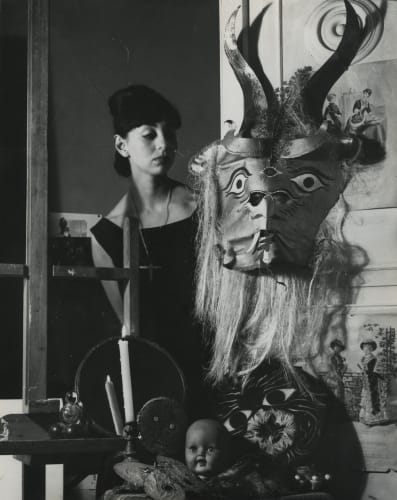Both cosmopolitan and avant-garde, Kati Horna (1912-2000) is mainly known for her photos of the Spanish Civil War taken between 1937 and 1939 for an album commissioned by the Spanish Republic, as well as her friendship with Robert Capa. Her work is characterised by the influence of the principles of surrealist Photography and her own moving approach to photojournalism and documentary photography. Kati Horna began her photographic career in the young Republic of Hungary in 1933. Newly-fatherless and staunchly political, photography offered Horna the means to earn a living and the chance to fulfil her political ideals. After enrolling at the most prestigious school of photography in Budapest, led by József Pécsi, she moved to Paris in 1933 where she turned her attention to the life she saw around her in the streets and cafés of the French capital. Her series Les Cafés de Paris (1934) captures her brilliant eye for irony and fun. This lighter mood however was soon overshadowed by the more serious images that history would dictate, namely the Spanish Civil War in 1936.
In Paris Horna was infected with the mood of the moment. She hurried to Madrid with her camera as a photographer for Anarchist magazines including Umbral, Tierra y Libertad, Tiempos Nuevos and Libre Studio. The conflict was the first major European war in which the civilian population bore the brunt of the violence, a tragic precursor to the world war that was around the corner. Horna, uniquely, saw that the real action was as much off the battlefield as on it. While her lifelong friend the photographer Robert Capa hiked up and down mountains in search of the most sensational front-line shots, Horna stayed in the scarred cities of Barcelona and Madrid, documenting the devastating effect of the war on ordinary people. Her pictures of elderly women, young children, babies and mothers are both heartbreaking in their immediacy and visionary in their choice of subject matter and images such as her breastfeeding woman in a Madrid refugee camp present the dignity and the strength of women under siege, as well as their predicament.
World War II prompted Horna’s final move to Mexico, her adopted country. It was in Mexico that Horna found her artistic community, among the surrealist ex-patriots Leonora Carrington, Remedios Varo and Edward James as well as Benjamin Péret and Emerico ‘Chiki’ Weisz. Here she developed her surrealist photography including extraordinary creations featuring masks and dolls. She is situated at the forefront of the 1960’s Mexican artistic avent-garde.
Kati Horna’s prints are included in renowned private and public collections worldwide.
Woman and mask, City of Mexico, 1963
19 x 24 cm (7.4 x 9.5“)
Vintage silver gelatin print
Domingo en Chapultepec Park, Mexico, 1959
19 x 24.1 cm (7.4 x 9.5“)
Vintage silver gelatin print
Alberto Gironella con un maniquí en la obra teatral La ópera del orden, Mexico, 1962
22.8 x 18.8 cm (9 x 7.4“)
Vintage silver gelatin print
In total we will be exhibiting 40 works from 18 artists at Aipad this year.
Contact for more information or EXPLORE THE EXHIBITION PAGE
AIPAD PHOTOGRAPHY SHOW 2015
16 - 18 April, New York.


